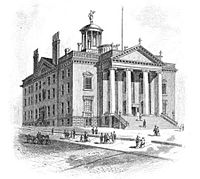41st New York State Legislature
| 41st New York State Legislature | |||||
|---|---|---|---|---|---|
|
|||||

The Old State Capitol (1879)
|
|||||
| Overview | |||||
| Jurisdiction | New York, United States | ||||
| Term | July 1, 1817 – June 30, 1818 | ||||
| Senate | |||||
| Members | 32 | ||||
| President | Lt. Gov. John Tayler (Dem.-Rep.) | ||||
| Party control | Democratic-Republican (27-5) | ||||
| Assembly | |||||
| Members | 126 | ||||
| Speaker | David Woods (Dem.-Rep.) | ||||
| Party control | Democratic-Republican | ||||
| Sessions | |||||
|
|||||
| 1st | January 27 – April 21, 1818 |
|---|
The 41st New York State Legislature, consisting of the New York State Senate and the New York State Assembly, met from January 27 to April 21, 1818, during the first year of DeWitt Clinton's governorship, in Albany.
Under the provisions of the New York Constitution of 1777, amended by the Constitutional Convention of 1801, 32 Senators were elected on general tickets in the four senatorial districts for four-year terms. They were divided into four classes, and every year eight Senate seats came up for election. Assemblymen were elected countywide on general tickets to a one-year term, the whole Assembly being renewed annually.
In 1797, Albany was declared the State capital, and all subsequent Legislatures have been meeting there ever since. In 1799, the Legislature enacted that future Legislatures meet on the last Tuesday of January of each year unless called earlier by the governor.
On February 24, 1817, Gov. Tompkins resigned, to take office as U.S. Vice President on March 4; and Lt. Gov. John Tayler became Acting Governor for the remainder of the legislative year, until June 30. On March 25, the Democratic-Republican State Convention nominated Canal Commissioner DeWitt Clinton for Governor, and Acting Gov. John Tayler for Lieutenant Governor. Clinton received 85 votes against 41 for Peter B. Porter (Buckt.). The Federalist Party did not nominate candidates for governor and lieutenant governor.
On April 6, 1817, State Senator Chauncey Loomis died, leaving a vacancy in the Western District.
On April 7, 1817, Tompkins County was created from parts of Cayuga and Seneca counties, and was apportioned two seats in the Assembly, one each taken from Cayuga and Seneca.
At this time the politicians were divided into two opposing political parties: the Federalists and the Democratic-Republicans. The Democratic-Republican Party was split into two factions: the Clintonians (supporters of Gov. DeWitt Clinton and his Erie Canal project) and the Bucktails (led by Att. Gen. Martin Van Buren, and including the Tammany Hall organization in New York City).
...
Wikipedia
